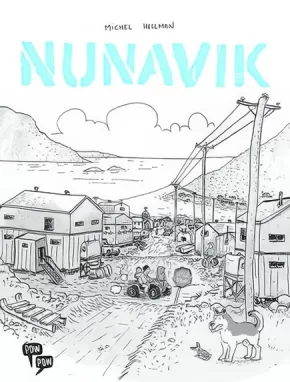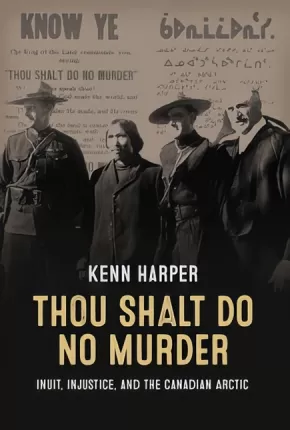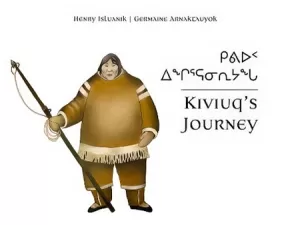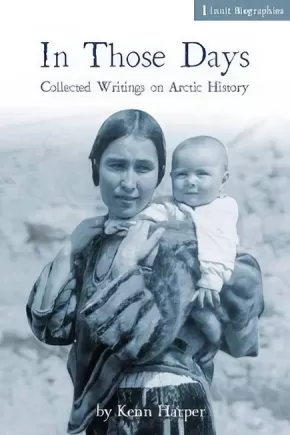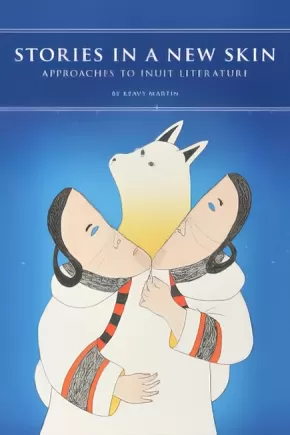
Inuit
31
-
40
of
40 Results;
Sort By
Go To
of 3
Nunavik (7 in Stock)
$22.95
Format:
Paperback
Text Content Territories:
Indigenous Canadian; Inuit;
Grade Levels: 12; University/College;
ISBN / Barcode: 9782924049358
Synopsis:
Synopsis:
Author Michel Hellman meets with his editor Luc Bossé and casually promises to write a sequel to his best-selling book Mile End. But the Montréal neighborhood, with its trendy cafés and gluten-free bakeries, doesn't seem half as inspiring as it used to be. Part memoir and part documentary, Nunavik follows Hellman on a trek through Northern Quebec as he travels to Kuujjuaq, Puvirnituk, Kangiqsujuaq and Kangirsurk, meeting members of the First Nations, activists, hunters and drug dealers along the way. An honest and often funny account of this trip, Nunavik truly feels personal, with the author acknowledging (and challenging) his own prejudices. While the North has had a profound influence on our collective identity as Canadians, it remains an idea - myth rather than reality. Empirical rather than theoretical, Nunavik reflects on the way our relationship to the North has shaped our own cultural landscape.
Reviews
"An insightful, self-reflexive memoir of the author's journey to small Inuit communities in Nunavik, the northern part of the province of Quebec. Hellman shares his thoughts and perceptions of the North while never losing sight of his own racial privilege." - Jarrah, Goodreads.com
Educator Information
Graphic Novel | Non-Fiction
Additional Information
156 pages | 6.25" x 8.25" | Black and white images
Thou Shalt Do No Murder: Inuit, Injustice, and the Canadian Arctic
$38.95
Format:
Hardcover
Text Content Territories:
Indigenous Canadian; Inuit;
Grade Levels: University/College;
ISBN / Barcode: 9781897568491
Synopsis:
Synopsis:
High Arctic, 1920: Three Inuit men delivered justice to an abusive Newfoundland trader.
This is the story of fur trade rivalry and duplicity, isolation and abandonment, greed and madness, and a struggle for the affections of an Inuit woman during a time of major social change in the High Arctic.
A show trial was held in Pond Inlet in 1923 that marked an end to the Inuit traditional way of life and ushered in an era in which Inuit autonomy was supplanted by dependence on traders and police, and later missionaries.
Kenn Harper draws on a combination of Inuit oral history, archival research, and his own knowledge acquired through 50 years in the Arctic to create a compelling story of justice and injustice in the far north.
Reviews
"While the amount of background information sometimes threatens to overwhelm the actual trial, this material is so interesting — and Harper's writing so vibrant — that it does not impede the narrative, or preclude thought-provoking questions about Canada's long-standing and ongoing negative treatment of the Inuit."— Quill & Quire
Additional Information
400 pages | 6.00" x 9.00" | 70 photos | Bibliography | Index
Wrestling with Colonialism on Steroids: Quebec Inuit Fight for their Homeland
$15.95
Format:
Paperback
Text Content Territories:
Indigenous Canadian; Inuit;
Grade Levels: 12; University/College;
ISBN / Barcode: 9781550654684
Synopsis:
Synopsis:
For decades, the Inuit of northern Québec were among the most neglected people in Canada. It took The Battle of James Bay, 1971-1975, for the governments in Québec City and Ottawa to wake up to the disgrace.
In this concise, lively account, Zebedee Nungak relates the inside story of how the young Inuit and Cree "Davids" took action when Québec began construction on the giant James Bay hydro project. They fought in court and at the negotiation table for an accord that effectively became Canada's first land-claims agreement. Nungak's account is accompanied by his essays on Nunavik history. Together they provide a fascinating insight into a virtually unknown chapter of Canadian history.
Additional Information
112 pages | 5.00" x 7.50"
The Right to Be Cold: One Woman's Story of Protecting Her Culture, the Arctic and the Whole Planet
$22.00
Format:
Paperback
Text Content Territories:
Indigenous Canadian; Inuit;
Grade Levels: 12; University/College;
ISBN / Barcode: 9780143187646
Synopsis:
Synopsis:
One of Canada's most passionate environmental and human rights activists addresses the global threat of climate change from the intimate perspective of her own Arctic childhood.
The Arctic ice is receding each year, but just as irreplaceable is the culture, the wisdom that has allowed the Inuit to thrive in the Far North for so long. And it's not just the Arctic. The whole world is changing in dangerous, unpredictable ways. Sheila Watt-Cloutier has devoted her life to protecting what is threatened and nurturing what has been wounded. In this culmination of Watt-Cloutier's regional, national, and international work over the last twenty-five years, The Right to Be Cold explores the parallels between safeguarding the Arctic and the survival of Inuit culture, of which her own background is such an extraordinary example. This is a human story of resilience, commitment, and survival told from the unique vantage point of an Inuk woman who, in spite of many obstacles, rose from humble beginnings in the Arctic to become one of the most influential and decorated environmental, cultural, and human rights advocates in the world.
Awards
- 2015 Ontario Historical Society Huguenot Society of Canada Award Winner
Reviews
"Loss, suppression and ultimate rediscovery of voice are themes that run through this courageous and revelatory memoir." —Naomi Klein, The Globe and Mail
"This is a book that needs to be read as the North becomes central to our future. It offers a perspective grounded in the culture and wisdom of northern people, seen through the lens of a remarkable woman as they seek to preserve 'The Right to be Cold.'" —Lloyd Axworthy, academic, former Minister of Foreign Affairs, and Nobel Peace Prize nominee
"This is a moving and passionate story from a committed woman who has bridged the ice age to the digital age. Her sophisticated views on the environment and the way the world works from her engaged involvement are brilliant and convincing." —The Right Honourable Adrienne Clarkson, journalist and former Governor General
Educator Information
This resource is also available in French: Le droit au froid: Combat d'une femme pour proteger sa culture, l'Arctique et la planete
Additional Information
|
Kiviuq's Journey
$19.95
Artists:
Format:
Paperback
Text Content Territories:
Indigenous Canadian; Inuit;
ISBN / Barcode: 9781927095805
Synopsis:
Synopsis:
Kiviuq's Journey retells the legend of Kiviuq, one of the most important and well-known legends in all of Inuit mythology, just as it as been told in the Kivalliq region of Nunavut for centuries.
Late Kivalliq-region elder Henry Isluanik lovingly retells this legend of the a lost Inuit hunter who must pass through many obstacles, using his own knowledge and quick wit to outsmart many foes, in order to find his way home.
With black-and-white line illustrations by acclaimed Inuit artist Germaine Arnaktauyok, this book is a definitive and authentic printed account of an important Inuit traditional story.
Intended for adult readers, this is a perfect selection for Inuit studies students.
Sanaaq: An Inuit Novel
$24.95
Format:
Paperback
Text Content Territories:
Indigenous Canadian; Inuit;
Grade Levels: 12; University/College;
ISBN / Barcode: 9780887557484
Synopsis:
Synopsis:
Sanaaq is an intimate story of an Inuit family negotiating the changes brought into their community by the coming of the qallunaat, the white people, in the mid-nineteenth century. Composed in 48 episodes, it recounts the daily life of Sanaaq, a strong and outspoken young widow, her daughter Qumaq, and their small semi-nomadic community in northern Quebec. Here they live their lives hunting seal, repairing their kayak, and gathering mussels under blue sea ice before the tide comes in. These are ordinary extraordinary lives: marriages are made and unmade, children are born and named, violence appears in the form of a fearful husband or a hungry polar bear. Here the spirit world is alive and relations with non-humans are never taken lightly. And under it all, the growing intrusion of the qallunaat and the battle for souls between the Catholic and Anglican missionaries threatens to forever change the way of life of Sanaaq and her young family.
Caution: Contains some mature content.
Educator Information
“Sanaaq is an unpretentious collection of fictional vignettes depicting Inuit family life in the 1950s Canadian eastern arctic. The author wrote at the request of an anthropologist attempting to learn Inuktitut and seeking to understand the context of specific words and terms.
Additional Information
248 pages | 5.50" x 8.50"
In Those Days: Inuit Lives - Book 1 (6 in stock) - ON SALE
$15.00 $19.95
Format:
Paperback
Text Content Territories:
Indigenous Canadian; Inuit;
Grade Levels: University/College;
ISBN / Barcode: 9781927095584
Synopsis:
Synopsis:
Arctic historian Kenn Harper gathers the best of his columns about Inuit history, which appear weekly in Nunatsiaq News, in this exciting new series of books.
Each installment of In Those Days: Collected Columns on Arctic History will cover a particularly fascinating aspect of traditional Inuit life. In volume one, “Inuit Biographies,” Harper shares the unique challenges and life histories of several Inuit living in pre-contact times.
The result of extensive interviews, research, and travel across the Arctic, these amazing short life histories provide readers with a detailed understanding of their specific time and place.
Series Information
This book is part of the In Those Days series, a historical series that collects writings on Arctic history.
Additional Information
200 pages | 6.00" x 9.00"
Settlement, Subsistence, and Change Among the Labrador Inuit
$27.95
Editors:
Format:
Paperback
Text Content Territories:
Indigenous Canadian; Inuit; Labradormiut (Labrador Inuit);
ISBN / Barcode: 9780887557316
Synopsis:
Synopsis:
Framed by the historic 2005 signing of the Labrador Inuit Land Claim Agreement and the creation of Nunatsiavut, the first Inuit self-government, Settlement, Subsistence, and Change Among the Labrador Inuit is a history of land and resource use by the Labrador Inuit. It examines in detail the way of life and cultural survival of this unique indigenous population, including household structure, the social economy and organization of wild food production, forced relocations and land claims, subsistence and settlement patterns, and contemporary issues around climate change, urban planning, and self-government. Comprised of twelve essays, this volume represents the first significant publication on the Labrador Inuit in more than thirty years.
Stories in a New Skin: Approaches to Inuit Literature
$27.95
Format:
Paperback
Text Content Territories:
Indigenous Canadian; Inuit;
ISBN / Barcode: 9780887557361
Synopsis:
Synopsis:
In an age where southern power-holders look north and see only vacant polar landscapes, isolated communities, and exploitable resources, it is important to point out that the Inuit homeland is, in fact, united by extensive philosophical, political, and literary traditions. Stories in a New Skin is a seminal text that confirms the “national” scope of Inuit literature and introduces a model for Inuit literary criticism. Author Keavy Martin analyzes writing and storytelling from a range of genres and historical periods – the classic stories and songs of the oral tradition, life writing, oral histories, and contemporary fiction, poetry, and film – and discusses the ways in which these texts constitute a national literary tradition. She highlights characteristics of Inuit intellectual discourse, demonstrates potential approaches to the material, and introduces ways of drawing methodologies from the texts themselves.
Reviews
"Martin has listened carefully to indigenous authors and critics who have for decades argued that their literature should be analyzed on its own terms, according to tribal and community perspectives and in keeping with indigenous knowledges. While Martin is not Inuit, she has gone to great lengths to visit the Far North, learn Inuktitut, and live for periods of time among the people. This lived experience, combined with her excellent literary theoretical and analytical skills, has produced this gorgeous book. In it Martin brings new perspectives to published and oral texts. As she argues, the most appropriate and sophisticated approach to Inuit stories is to recognize how both tradition and adaptation have shaped them."— Jury's Comments, 2012 Gabrielle Roy Prize
Kappianaqtut: Strange Creatures and Fantastic Beings From Inuit Myths and Legends
$19.95
Artists:
Format:
Paperback
Text Content Territories:
Indigenous Canadian; Inuit;
ISBN / Barcode: 9781926569383
Synopsis:
Synopsis:
Each volume in the Kappianaqtut series provides readers with an in-depth academic examination of two mythological creatures from Inuit mythology. The series examines Inuit myths from an ethnographic perspective and fosters discussion on the variations and multiple representations of the myths and creatures in question.
This volume, which explores the giants of the North and the mother of the sea mammals, has been fully revised and updated.
Kappianaqtut represents the first book-length study of Inuit mythological beings written from a Northern perspective.
Sort By
Go To
of 3

